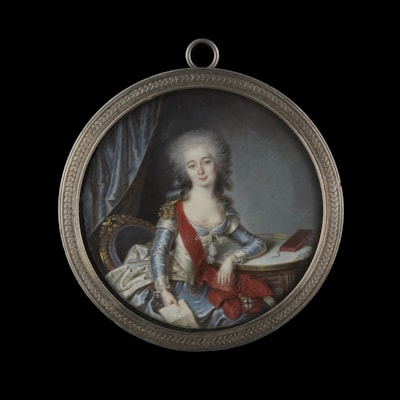OZIAS HUMPHRY
(1742-1810)Portrait of the Actress Clara Hayward (fl. 1770-1772), as Clarista from The Fair Penitent (published 1703), seated and wearing a dark blue dress, white chemise and fichu, her powdered wig curled in rolls and upswept; dated 1772
Watercolour on ivory
Ivory licence number: KWC51QYV
Signed on the reverse and dated 'Ozias Humphry/ pinxt 1772/ Miss Clarissa Hayward'
Gold frame with pearl border
Oval, 102 mm (4 in) high
SOLD
It is from this 1776 issue that one of the only other known depictions of Miss Hayward comes. This is much less flattering than Humphry’s, showing her with a square chin and satirically high hair. Given the nature of the publication [1], it is probable that these features were intended to disguise Miss Hayward. In the present miniature, the actress is depicted clasping her hands together, as Calista from The Fair Penitent by Nicholas Rowe (1703). Within the play, the character of Calista is entangled in an unhappy, arranged relationship with the character Lothario, when she is in fact in love with the character Altamont. At the end of the play, Lothario is killed. The play has traditionally been called a ‘she-tradgedy’, however, modern scholarship has questioned whether or not Calista is really a protagonist in the story [2].
The miniature has an interesting provenance and remained in the artist’s collection until his death. It can be assumed that this miniature is the same portrait of Miss Clarina Hayward as The Fair Penitent listed in the 1810 sale of the artist’s possessions and that the misspelled name comes from a misinterpretation at the time or since. If this is the only version of the miniature, then Humphry must have painted this for himself and not as a commission. The sketchy handling of the work, which only adds to the sense of intimacy and delicacy of the sitter, would be explained by this origin. This allows the viewer to feel that Calista’s penitence is genuine and captures a snapshot of the skill for acting that Miss Hayward had.
Ozias Humphry was known as the ‘Reynolds in Little’ and was known for his copies of the great portraitist, who he was also well-acquainted with. Many of his portraits were painted on large pieces of ivory, like in this example [3]. Like his contemporary John Smart (1741-1811), Humphry was born to a peruke (wig) maker in Devon. Following a successful career, he was forced to stop painting as his eyesight began to fail him.
[1] Within the article on the couple in the February 1776 edition, their names are also half-disguised. It is likely that censoring the names and providing caricatures instead of likenesses were both tactics used by the magazine to avoid libel.
[2] For further discussion, see Charlie Macrowan, Sex and Society: Analytical Exercise The Fair Penitent, Act Four, Lines 117-266, Leading Undergraduate Work in English Studies, volume 3, 2010-11, pp.230-234.
[3]A portrait of Colonel Duff (after 1790), previously with the Limner Company, was also of a particularly large format, at 15 x 11 cm (5 ⁷/₈ x 4 ³/₈ inches).
Bonhams, London, 22 March 1994, lot 200;
Bonhams, London, 21 November 2013, lot 66;
Private Collection, UK.

shipping notice
Worldwide shipping is included in all prices.
The Limner Company does not accept any responsibility for import duty, this is to be paid by the buyer.
Some stock items contain materials from endangered species which are governed by CITES regulations and will require a permit to export outside of Great Britain. If a certificate of export is required then this will be the responsibility of and paid for by the buyer .
you may also like













